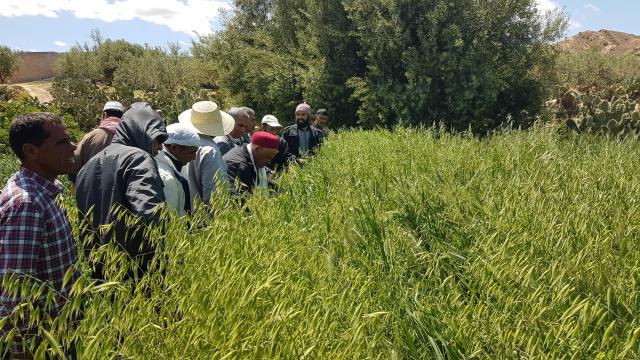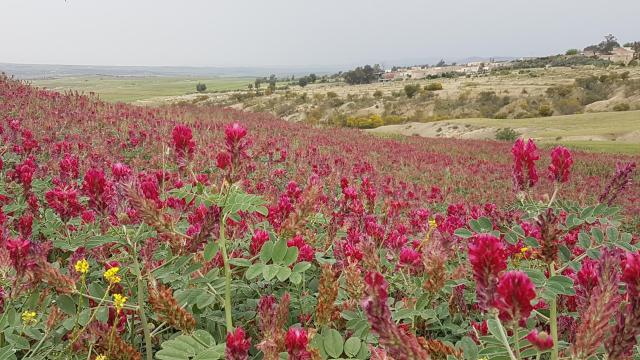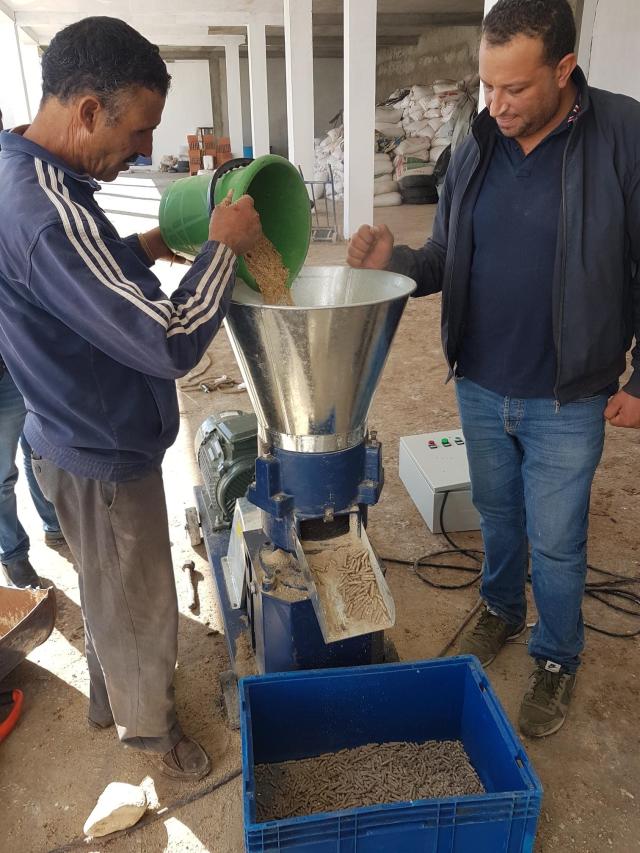Addressing feed gap using resilient forage-based feed options and densification: A perspective from Tunisia with wider applicability
2 Alliance of Bioversity International, CIAT P.O. Box 823-00621, Nairobi Kenya
3 Independent consultant, Vienna Austria
4 Founder and Principal Consultant. Seeds & Feed for Development, LLC. *Correspondence: bhramar.dey@sf4dev.com
In the face of animal feed insecurities, the present perspective focuses on Tunisia and explores the potential of locally available materials - such as, forages and by-products - to increase quality feed supply in the country. Forage production from a mix of forage species (triticale, oats, fenugreek, and vetch) in different proportions to pellet production using a mix of grains of maize, barley and soybean and locally available feed ingredients such as date palm byproducts, grain brans, tomato plant, saline-tolerant local alfalfa, among others are being increasingly used by small and medium farmers. Business models through public-private partnerships that include feed densification technologies like pelletization provide a novel solution to spatially configure feed supply in the north and demand sink in southern Tunisia where agroecological conditions are arid. With appropriate and effective policy and enabling environment, these adaptive strategies that build local resilience have applicability in Tunisia and beyond.
1. Introduction
Smallholder farmers predominantly practice mixed farming systems. High quality animal feed is essential for increasing animal productivity, and food security includes animal feed security. Thus, innovations that decrease the cost of high-quality animal feed are essential steps for economies where livestock plays a key role. In Tunisia, livestock is a major agricultural activity comprising about 759,000 cattle, 7 million sheep, 1.5 million goats and 70,000 camels and contribute 4% to the country’s GDP (INS, 2015). The country is largely located in arid and semi-arid conditions receiving less than 200 mm of rainfall annually in the south, around 350 mm in the center and 500 mm in the north (Hamdan et al., 2006), resulting in huge spatial and temporal variation in feed availability. Thus, sustained access to adequate quantities of high-quality feed, that takes about 70% of the costs (Makkar, 2016; Odero-Waitituh et al., 2017), remains a consistent challenge for livestock production in Tunisia, constraining its growth and efficiency.
Despite those challenges, Tunisia has demonstrated with examples through innovative technologies that are based on locally available materials (such as dates, olives, tomatoes, cactuses, and forages) to provide local solutions that could provide high-quality animal feed, even during dry periods. Feed densification and preservation technologies such as pelletization, in collaboration with private entities to ensure year-round availability of quality feed, are examples that could be borrowed from Tunisia as advancements to be applied in countries such as Ethiopia, Sudan, Zambia and others in the middle east.
The USAID (United States Agency for International Development) funded Global Activity S34D (Supporting Seed Systems for Development) conducted several assessments and studies on role of cultivated forages in animal feed strategies and especially on feed preservation technologies including forage-based pelletization to provide total mixed rations (TMR) for dairy and small ruminants (Dey et al., 2022,Mwendia et al., 2023a; Mwendia et al., 2023b). The current perspective is based on that research and a field study in Tunisia. The objective of the visit to Tunisia was to learn from the International Center for Agricultural Research in the Dry Areas (ICARDA) in addressing the feed gap in Tunisia. ICARDA has immense experience on forage densification technology and is deploying new models on the ground to address livestock feed security in the country. During the field study in October 2023, an array of stakeholders was consulted – private sector entities who supply agricultural machinery, farmer cooperatives that produced pellets, regional research centers, and individual farmers in Douz, Tunisia.
The visit prompted a discussion on gaps and opportunities in using densification of improved forages and the constraints to scale the approach across the country. The pluralism on the ground of research partners and farmer cooperatives is rapidly advancing suitable locally adapted technologies, which is supported by private sector investment on machinery, allowing for the development of suitable business models. Learning from a technical, operational and policy perspective within the context of existing literature allows for future directions that would be applicable and relevant for several other countries where livestock plays a key role in economic growth and food security.
The current perspective summarizes the technological advancements made by Tunisia and the roles played by international and national research centers in fostering public-private partnerships to drive business models on the ground. The locally adapted solutions are not only sustainable, but also resilient in the face of climate changes experienced in the dry regions of the country. Section 2 discusses the advancements in Tunisia. Future directions are suggested in Section 3 while concluding remarks are summarized in Section 4.
2. A perspective
Exploring local solutions to increase options to reduce animal feed scarcity is a must to adapt to climate change in arid and semi-arid regions. Tunisia is exemplary in its efforts to display, implement, and advocate for locally adaptable solutions and technologies that embrace pluralism of actors – from international research centers to national partners, private sectors and farmer-based cooperatives.
2.1 Feed Technology Advancements in Tunisia
As basic ingredients, several forages aside from barley and spineless cactus were tested in Tunisia, the most prominent forages being triticale, oats, fenugreek and vetch (Figure 1a).

Figure 1a. Forage mixture (Vetch-Triticale-Oats) in Tunisia (Photo credit: Udo Rüdiger)
Forages are usually planted in November / December and cut in April, but if seeds are to be harvested, crops are kept in the field until June. Some supplemental irrigation is usually given to these forages. The crops are fed in different proportions depending on soil and agro-climatic conditions. Forages are cultivated in rotation (one year, cereals i.e. barley and the next year the forage mixtures). Triticale and vetch combinations in 40% and 60% respectively are also used by farmers, while Sulla forage (Figure 1b) is used for rangeland management to contribute to better feed quality. All this biomass can be densified in the form of pellets to overcome seasonal shortages, allowing to store the condensed feed over time, reducing storage and transport costs and being able to obtain saleable products which can be easily transported locally.

Figure 1b. Sulla forage legume for rangeland in Tunisia (Photo credit: Udo Rüdiger)
Since 2016, ICARDA and national partners such as INRAT (National Institute of Agronomic Research of Tunisia and the Institut Des Régions Arides) are pursuing the opportunity of feed densification. GIZ (Deutsche Gesellschaft für Internationale Zusammenarbeit) funded the “red meat value chain” and “Mind the Gap” projects originally to test adoption of feed blocks (ICARDA, 2017). As the adoption rate was very low, the technology approach was shifted to feed pelletizers (ICARDA, 2022). Pelletization was first explored in 2019 within the “CGIAR Research Program (CRP) on livestock – feed and forages” through the development and testing of a locally produced pelletizer. Unfortunately these were not very efficient and since 2021, ten pelletizing machines have been imported within several projects in Tunisia. Pelletization has been successful in research and local application in Tunisia and elsewhere e.g. India (FAO, 2012), and their economic viability also has been assessed for Ethiopia, Zambia and Sudan (Dey et al., 2022; Mwendia et al., 2023a; Mwendia et al., 2023b). Preservation and densification of cultivated forages is identified as a promising solution especially for distant demand sinks such as feedlots, animal quarantine centers, dairy hubs, and pastoral communities prone to climate change risks.
However, expansion is constrained by feed resources in drought prone environments due to limited opportunity for irrigation, inadequate availability of suitable forage planting material, and small-scale businesses and limited accessibility of mechanized equipment at an affordable cost.
2.2 A case of pellet feed use in Tunisia
Pellets produced (Figure 2a) in Tunisia so far contained largely dates (wasted) (ca 20%), wheat bran (ca 12%), tomato plant (ca 12%) and date branches (twigs attached to dates; pedicels) and other locally available biomass e.g. pomegranate peels.

Figure 2a. Medium-sized feed pellet machine (Photo credit: Udo Rüdiger)
Other materials used for pelleting are alfalfa plus tomato plant, and faba beans that could be added in place of alfalfa to increase crude protein (CP) content. The pellets have CP of around 12%. Urea is sometimes added at a level of 1 to 2% in the TMR to increase the CP level to 16%. The neutral detergent fibre (NDF) content is around 20-45%. This level of NDF is vital for proper rumen function. Furthermore, a trial on pellets containing 20% pomegranate peels has been done on sheep (Figure 2b) leading to higher growth rate and improved meat quality. Intake of animals was higher at lower levels of pomegranate peels, which apparently is due to the presence of tannins as bioactive compounds.

Figure 2b. Sheep feeding on pellets (Photo credit: Udo Rüdiger)
Farmers in Tunisia are supported in three different ways by the cooperatives: a) all ingredients used for pelleting are provided by the cooperative, and the pelleted feed is provided to the cooperative members at a rate set by the cooperative, b) the ingredients for pelleting are provided by the farmers and pelleting is done by the cooperative, at a rate lower, and c) the mix of a) and b). Currently pelleted feed production is not large and hence provided only to cooperative members, and not sold in the market. The pellets produced by the cooperatives have been well accepted by farmers.
According to farmers, the main advantage is the saving on feeding time. Currently, pellet feed formulation (crude protein varying from 9-12% without urea, and 16% with 1-2% urea) is only for the small ruminants, used as a supplementary feed to the grazing. There is a need for diversification of the formulas to reach all categories of ruminants and for all physiological stages. Table 1 shows an economic analysis of the costs of feed densification which compares favorably with alternatives such as imported feed concentrates, which is around 1300 TD/t (Dhehibi et al., 2022). Depending on the capacity of the pelletizer, the cost of pelleted feed is 42 to 72% lower. The cost of production using the smaller pelletizer was lower than that from the larger pelletizer. The reason appears to be the lower labor and use of the locally available biomass for pellet production.
| Case 1 (large pelletizer - operated in south)** | Case 2 (large pelletizer - operated in center)** | Case 3 (small pelletizer - operated in center)* | |
|---|---|---|---|
| Production costs (TD/ t) | 714 | 550 | 340 |
| Production per year (t) | 1,200 | 1,200 | 360 |
| Selling price (Td/t) | 750 | 600 | 370 |
| Return per year (Td) | 900,000 | 720,000 | 133,200 |
| Gross margin (Td) | 43,200 | 60,000 | 10,800 |
*Small pelletizer, 120 - 150 kg / h; **large pelletizer 500 – 600 kg / h. Source: ICARDA
3. A way forward
To ensure local viability, we propose a basic business plan incorporating a marketing strategy tailored to the local context. This plan would involve investing in knowledge and skills related to pellet ingredients and fostering partnerships with fellow farmers, organizations, and the local private sector, thereby enhancing the sustainability of these endeavors.
Operating and scaling business strategies need access to the feed ingredients. However, in Tunisia, access to adequate amount of the ingredients is limited in time and space (e.g. olive cakes). To scale the access to a diverse set of locally and nationally available feeds in the country, there would be a need to ensure additional resources which may either be limited (such as, the case of by-products) or may be constrained in view of high production costs (such as alfalfa cultivation under irrigation).
Adapted forages could provide an option. However, in southern Tunisia these would also be constrained by arid agro-ecological conditions. A way forward could be a spatial integration between the more favorable areas in the north (with higher rainfall) with the demand sink in the south. For example, there is an opportunity that forages such as increased quantities of alfalfa and oats hay could be produced and densified into pellets in the north to increase shelf-life and decrease storage and transport costs. A part of this densified feed could meet the severe feed deficit in the south.
Exploring the feasibility of pelleting units for the private entities would, however, require changes in existing policies to obtain quota for barley and wheat bran from the government (needed for most pellet formula) which currently do not exist. Additionally, on the ground facilitation and dialogues with policymakers would be needed to obtain licenses for feed production and commercialization for the farmer-based organizations that will allow enough feed to move between regions. Agricultural policies that favor domestic manufacturing of pelleting machines in Tunisia would also need to be institutionalized. Finally, access to finance to start a business (purchase of pelletizer and ingredients) and wider access to three-phase electric supply would accelerate the scaling-up and sustainability of the pellet supply process.
4. Conclusion
Densification technology based on a mixture of locally produced feed ingredients offer a possibility to reduce the feed gap in Tunisia thus intensifying livestock production to respond to the demand pull. Rapid economic analysis indicates the viability of the approach when compared to imported concentrates.
However, although densification as a technology works, the supply of materials for densification remains a challenge as volumes are often not readily available to keep the machines running to capacity. The use of by-products alone will not supply adequate quantities. This requires concerted efforts on the possibility of growing forages to bridge the gap between feed demand and supply.
There is spatial and seasonal difference in suitability of agroecological conditions to produce forages. Densification would allow for a stronger spatial and temporal integration of feed production. Previous efforts in Tunisia that engaged only farmers in feed processing did not result in scaling. Thus, to ensure sustainability and scalability, densification should be conducted by private businesses, as opposed to only training farmers to do the densification e.g. pellet production.
Government support is essential in all cases to provide effective policies and an enabling environment suitable for private entities. The identification of novel feeds, the combination with available feed materials, and densification of these seem to have tremendous potential to overcome feed limitations in quantity and quality, both temporarily and spatially.
5 References
- Dey, B., Notenbaert, A., Makkar, H., Mwendia, S., Sahlu, Y., Peters, M. (2022). Realizing economic and environmental gains from cultivated forages and feed reserves in Ethiopia. CAB Reviews: Perspectives in Agriculture, Veterinary Science, Nutrition and Natural Resources, 2022(2022). https://doi.org/10.1079/cabireviews202217010
- Dhehibi B., Oussama, J., Frija A., Rüdiger U, Ouerghemmi H., Idoudi Z., Rekik M., Elayed M., Zaiem A., Moujahed N. (26/10/2022). Profitability of Manufactured Feed Pellets for Small-Scale Crop-Livestock Farmers in Tunisia. Beirut, Lebanon: International Center for Agricultural Research in the Dry Areas (ICARDA), (https://repo.mel.cgiar.org/handle/20.500.11766/67922
- FAO (2012). Crop residue based densified total mixed ration https://www.fao.org/4/i2728e/i2728e00.htm
- Hamdan I., T. Oweis and G. Hamdallah (eds.) AARINENA Water Use Efficiency Network: Proceedings of the Expert Consultation Meeting, 26-27 November 2006, Aleppo, Syria. ICARDA, Aleppo, Syria. iv + 244 pp
- ICARDA (2017) Improving the red meat value chain in Tunisia. Provision of proven feed resource technologies to improve the red meat value chain in Tunisia | ICARDA
- ICARDA (2022) Low-cost machinery for better rural livelihoods in Tunisia. Low-cost machinery for better rural livelihoods in Tunisia | ICARDA
- INS, National Institute of Statistics, Expenditure Statistic of Consumption and Living Conditions of Households, Tunis, (2015). (in Arabic)
- Makkar HPS. 2016. Animal nutrition in a 360-degree view and a framework for future R&D work: Towards sustainable livestock production. Animal Production Science 56(10):1561–1568. doi: 10.1071/AN15265
- Mwendia, S., Dey, B., Makkar, H., Notenbaert, A., Ngoma, N., Peters, M. (2023). Unexploited economic and environmental benefits from cultivated forages in Zambia. CABI Reviews, 1–13. https://doi.org/10.1079/cabireviews.2023.0038
- Mwendia S, Dey, B., Mohammed M.I., Makkar., H., Notenbaert A., Peters M. (2023) Role of cultivated forages in Sudan. https://pdf.usaid.gov/pdf_
docs/PA021G2T.pdf - Odero-Waitituh JA. 2017. Smallholder dairy production in Kenya; a review. Livestock Research for Rural Development 29(7):139. lrrd.org/lrrd29/7/atiw29139.html

